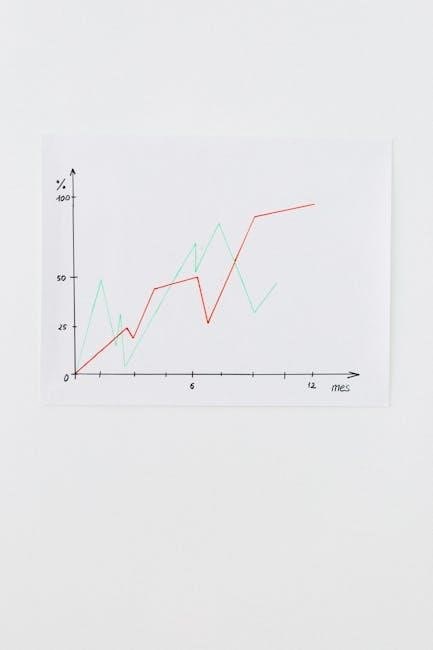Potty training charts are tools designed to help toddlers visualize progress and stay motivated. Free printable PDF options offer customizable templates with themes and stickers, making the process engaging and effective.
What is a Potty Chart?
A potty chart is a visual tool designed to track a child’s progress during toilet training. Typically available as a printable PDF, it allows parents to mark successes and setbacks. These charts often feature fun themes, stickers, and illustrations to engage children. They serve as a motivational aid, helping kids visualize their achievements and stay encouraged throughout the potty training journey. Customizable options ensure the chart fits individual needs and preferences.
Importance of Visual Aids in Potty Training
Visual aids, like printable potty charts, play a crucial role in potty training by providing a clear and engaging way for children to track their progress. These tools use colors, stickers, and illustrations to capture a child’s attention, making the learning process fun and interactive. By offering a tangible way to see achievements, visual aids boost motivation and help children understand the cause-and-effect relationship between using the potty and earning rewards, fostering a sense of accomplishment and independence.

Benefits of Using a Potty Chart
Potty charts help track progress, motivate children with rewards, and foster independence. They make learning engaging and celebrate small achievements, building confidence and consistency.
Motivation Through Rewards
Rewards are a powerful motivator for children during potty training. Using stickers, stars, or small prizes on a potty chart encourages consistency and effort. Seeing progress visually boosts their confidence and excitement. Rewards create a sense of accomplishment, making the process fun and engaging. This positive reinforcement helps children stay focused and eager to learn, turning potty training into a rewarding experience for both kids and parents.
Tracking Progress and Consistency
A potty chart printable PDF helps track daily progress, making it easier to identify patterns and consistency. By marking successful attempts, children and parents can visualize improvements over time. This tool fosters accountability and helps maintain a routine, ensuring the child stays on track. Regular updates also allow for celebrating small milestones, reinforcing the importance of persistence and effort in the potty training journey.
Encouraging Independence in Children
A potty chart printable PDF empowers children to take ownership of their progress, fostering independence. By allowing them to mark their achievements, kids develop a sense of control and responsibility. This visual tool helps children track their own success, building confidence and self-reliance. As they see their accomplishments grow, they become more motivated to continue without constant supervision, fostering a sense of pride and autonomy in their learning process.

How to Create a Custom Potty Chart
Design a custom potty chart by defining goals, choosing colors, and adding child-friendly visuals. Use tools like Canva or Excel to personalize the layout, ensuring it’s engaging and functional for tracking progress effectively. Include spaces for stickers or checkmarks to mark milestones, making it interactive and tailored to your child’s preferences for a fun learning experience.
Designing Your Own Template
Start by selecting a layout that suits your child’s needs. Use a grid or chart format with rows for days and columns for successful uses. Incorporate bright colors and themes to make it visually appealing; Add sections for stickers or checkmarks to track progress. Use software like Canva or Excel to design the template, ensuring it’s easy to customize. A well-designed template will keep your child motivated and engaged throughout the potty training journey.
Adding Themes and Stickers
Add fun themes like cartoons or animals to make the potty chart appealing. Use colorful stickers as rewards for successful attempts, placing them on the chart to mark progress. Themes can be personalized to match your child’s interests, while stickers add an interactive element. This combination creates a visually engaging and motivating tool for your child, making the potty training process enjoyable and rewarding.
Customizing for Individual Needs
Customize potty charts to suit your child’s preferences and requirements. Choose color schemes or layouts that appeal to them. For children with special needs, incorporate symbols or pictures for better understanding. You can also add their name or favorite characters to make it personal. This tailored approach ensures the chart feels unique and engaging, fostering a sense of ownership and motivation during the potty training journey.

Downloading and Printing Potty Charts
Potty chart printable PDFs are widely available online, offering easy customization and printing. Adjust sizes and colors as needed for a professional finish at home using cardstock and vibrant ink.
Free Printable PDF Options
Free printable PDF potty charts are readily available online, offering customizable templates for parents. Websites like Pinterest, Etsy, and specialized parenting blogs provide vibrant designs. Choose from themed charts featuring animals, cartoons, or simple grids. Many PDFs allow personalization, such as adding your child’s name or preferred rewards. Print on sturdy paper or cardstock for durability. These free resources make potty training engaging and fun, with options to suit every child’s preferences and learning style.
Choosing the Right Format (PDF, PNG, JPG)
When selecting a potty chart, consider the format. PDFs are ideal for printing and editing, maintaining quality at any size. PNGs offer transparent backgrounds, great for digital customization. JPGs are compact but may lose quality when resized. Choose PDF for printable charts, PNG for digital versatility, and JPG for quick sharing. Each format suits different needs, ensuring your potty chart looks its best whether printed or shared online.
Printing Tips for Best Results
For optimal printing, use high-quality paper and vibrant ink settings. Ensure your printer is set to the correct dimensions for the potty chart. Choose “fit to page” or “actual size” to maintain clarity. Consider laminating the chart for durability. Test print on scrap paper first to avoid waste. Use bright colors to make the chart engaging for your child. Proper printing ensures the chart remains legible and visually appealing, fostering effective potty training.
Using the Potty Chart Effectively
Place the chart at eye level to engage your child. Update it consistently, involving them in the process. Praise their progress to boost motivation.
Placing the Chart at Eye Level
Positioning the potty chart at your child’s eye level ensures they can easily see their progress. This visibility boosts motivation and creates a sense of ownership. Place it near the bathroom or potty area for constant reminders. Use command strips or a sturdy frame to secure it. Seeing their achievements daily encourages consistency and pride in their efforts, making the potty training journey more engaging and effective for your little one.
Consistency in Updating the Chart
Regularly updating the potty chart is crucial for maintaining your child’s motivation. Each successful use of the potty should be immediately marked, showing clear progress. Consistency reinforces the routine and helps your child understand the cause-and-effect relationship between their actions and rewards. Stick to a daily schedule for updates and involve your child in the process, allowing them to place stickers or marks themselves. This shared responsibility strengthens their commitment to potty training.
Using Stickers as Rewards
Stickers are a powerful motivator for children during potty training. Placing a sticker on the chart after each successful attempt creates a visual reward, making the process engaging and fun. Choose colorful, themed stickers to capture their interest and celebrate progress. This simple yet effective method teaches cause-and-effect, encouraging repetition of positive behavior. Involve your child in selecting stickers to boost excitement and ownership of their achievements.

Popular Types of Potty Charts
Popular potty charts include daily, weekly, and visual designs. Each style caters to different learning preferences, helping children stay motivated and track their progress effectively;
Daily Potty Training Charts
Daily potty training charts are ideal for tracking progress in short intervals, helping children establish routines. These charts often include sections for morning and nighttime use, allowing parents to monitor consistency. By marking successful attempts with stickers or checks, kids can visually see their achievements, fostering motivation. Customizable options let parents tailor the chart to their child’s needs, such as adding specific times or extra notes. This tool encourages responsibility and celebrates small victories, making the learning process engaging and rewarding.
Weekly Progress Tracking Charts
Weekly progress tracking charts provide a broader view of a child’s potty training journey, helping identify patterns and improvements over time. These charts typically feature a grid spanning seven days, with spaces to mark successful uses, accidents, or missed attempts. Parents can use stickers or colors to differentiate outcomes, making it easier for children to visualize their progress. This long-term perspective helps build consistency and offers a sense of accomplishment as the week progresses.
Visual Charts with Illustrations
Visual charts with illustrations are engaging tools for potty training, using images to make the process fun and relatable. These charts often feature cartoon characters, animals, or simple designs that appeal to young children. Illustrations help non-readers understand the concept, while bright colors and themes keep kids motivated. Many printable PDFs allow customization, letting parents add their child’s name or favorite characters, making the chart feel personalized and exciting for little ones to use daily.
Real-Life Examples and Case Studies
Parents share success stories of using printable PDF potty charts, highlighting how visual rewards motivated their children to stay consistent and achieve faster results.
Success Stories from Parents
Many parents report significant progress using printable PDF potty charts. One mom shared that her child, Lily, went from accidents daily to full independence in weeks. Stickers motivated Lily, and the visual chart helped track her journey. Another parent praised the customizable PDFs, noting how themes and rewards boosted their twin boys’ confidence. These stories highlight how potty charts create a clear, positive path to success, making the process enjoyable and rewarding for both kids and parents.
How Different Families Use Potty Charts
Families tailor potty charts to suit their unique needs. Some busy parents use digital versions on phones, while others prefer printed charts hung in bathrooms. Large families customize charts for each child, using different themes or colors. Parents of special-needs children often simplify designs, focusing on clear visuals. This adaptability makes potty charts a versatile tool, allowing families to personalize the potty-training experience for their child’s learning style and environment.

Tips for Effective Potty Training
Consistency is key; establish a routine and stick to it. Use positive reinforcement and celebrate small milestones to build confidence and encourage progress.
Creating a Routine
Establishing a consistent schedule helps children adapt to potty training. Use a potty chart printable PDF to track progress and maintain structure. Set specific times for bathroom visits, such as after waking up, before meals, and at bedtime. Consistency reinforces learning, making the process smoother. Incorporate visual reminders and rewards to encourage adherence. A well-planned routine creates predictability, helping children feel secure and confident during training.
Celebrating Small Achievements
A key part of potty training is recognizing and celebrating progress. Use a potty chart printable PDF to acknowledge even minor successes, like sitting on the potty or staying dry. Stickers or stars on the chart serve as tangible rewards, boosting motivation. Praising efforts, no matter how small, fosters confidence and encourages continued effort. This positive reinforcement helps children stay excited about learning and builds a sense of accomplishment.
Handling Accidents Positively
Accidents are a natural part of potty training, and handling them positively is crucial. Stay calm and avoid scolding, as this can create negative associations. Instead, gently guide your child to the potty and encourage them to try again. Use the potty chart printable PDF to focus on progress, not perfection. Each accident is a learning opportunity, and consistent positivity helps build your child’s confidence and resilience throughout the process.

Troubleshooting Common Issues
Common issues include resistance, lack of interest, or inconsistent progress. Stay patient, adjust the chart to their needs, and celebrate small victories to keep motivation high.
When the Child Shows No Interest
If a child shows no interest in the potty chart, try making it more engaging. Let them choose the theme or stickers, and explain how it helps track their progress. Keep it fun and patient, emphasizing that it’s a tool to celebrate their growth. Small introductions and gradual involvement can spark curiosity and willingness to participate.
Dealing with Resistance
When a child resists using the potty chart, stay calm and patient. Avoid forcing participation, as this can create negativity. Instead, use positive reinforcement and explain how the chart helps them achieve their goals. Offer choices, like selecting stickers or themes, to make the process feel more personal. Pairing the chart with other motivational tools, such as rewards or praise, can also help overcome resistance and encourage cooperation.
Adjusting the Chart for Different Learning Styles
Customize the potty chart to suit your child’s learning style. For visual learners, use bright colors and engaging illustrations. Auditory learners may benefit from verbal praise when a sticker is added. Kinesthetic learners can enjoy placing stickers themselves. Tailor the chart’s design and rewards to match their preferences, ensuring it remains engaging and effective for their unique way of understanding and responding to the training process.

Combining Potty Charts with Other Training Tools
Pair potty charts with sticker rewards, apps, and educational books to create a comprehensive training approach; This combination enhances engagement and consistency, fostering successful potty training outcomes.
Using Sticker Charts and Reward Systems
Sticker charts and reward systems are powerful motivators for children during potty training. By placing a sticker on the chart for each successful use of the potty, kids feel a sense of accomplishment. Rewards, such as small toys or treats, can be offered when a certain number of stickers are collected. This combination of visual tracking and tangible incentives encourages consistency and excitement, making the process more engaging and effective for young learners.
Incorporating Potty Training Apps
Potty training apps can enhance the effectiveness of printable charts by offering interactive and engaging tools. Many apps feature games, sounds, and animations that celebrate successes, making the process fun for kids. They also provide real-time tracking and reminders, helping parents stay consistent. By combining apps with printable charts, families can create a balanced approach that caters to different learning styles, fostering a positive and dynamic potty training experience.
Pairing with Educational Books and Videos
Combining printable potty charts with educational books and videos enhances learning by providing engaging content. Books often feature relatable characters and stories that make potty training less intimidating. Videos add visual and interactive elements, such as songs or demonstrations, to reinforce the process. Together, these tools create a dynamic and immersive experience, helping children connect with the concept emotionally and intellectually while tracking progress with their charts.

Psychological Impact of Potty Charts
Potty charts positively influence a child’s mindset by fostering motivation, confidence, and a sense of accomplishment, aiding in emotional and developmental growth during training.
Building Self-Esteem
Potty charts play a significant role in boosting a child’s self-esteem by providing visual proof of their progress. Each successful use of the potty, marked on the chart, gives children a sense of accomplishment and pride. This positive reinforcement helps them feel capable and confident, fostering a strong sense of self-worth. Recognizing their achievements, even small ones, encourages children to take pride in their efforts, laying a foundation for healthy self-esteem development.
Teaching Cause-and-Effect Relationships
Potty charts help children understand cause-and-effect relationships by linking their actions to immediate outcomes. For example, using the potty correctly results in a sticker or checkmark on the chart, while accidents may mean no reward. This clear connection teaches children that their behavior leads to specific consequences, fostering responsibility and self-awareness. Over time, this structured approach helps them grasp how their choices impact their progress and goals.
Encouraging a Sense of Achievement
A potty chart printable pdf fosters a sense of achievement by allowing children to see their progress visually. Each sticker or checkmark represents a success, no matter how small, which builds confidence and pride. This visual evidence of accomplishments motivates children to continue striving for independence. Celebrating milestones, even minor ones, reinforces positive behavior and helps children feel capable, laying a strong foundation for future self-esteem and personal growth.
Potty chart printable PDFs are a simple yet effective tool for guiding children through their training journey. They provide clear structure, celebrate progress, and foster independence, helping parents and children achieve success together with confidence and pride.
Final Thoughts on Using Potty Charts
Potty chart printable PDFs offer a practical and engaging way to support children during their training journey. They help establish consistency, provide motivation, and visually track progress, making the process more manageable for both parents and kids. While they are a valuable tool, remember that every child is unique, and patience and adaptability are key. With dedication and positive reinforcement, potty charts can significantly contribute to a child’s confidence and readiness for this important milestone.
Encouragement for Parents
Remember, potty training is a journey, and every small step counts. Celebrate progress, no matter how minor, to boost your child’s confidence. Stay patient and consistent, as this builds trust and routine. Printable PDF charts are a simple yet effective tool to make the process enjoyable and rewarding. Don’t compare your child’s pace to others—every journey is unique. With time and encouragement, your child will master this milestone, and the sense of accomplishment will be worth the effort.
Next Steps After Potty Training
After successfully completing potty training, parents can gradually phase out the use of potty charts; Transitioning to underwear full-time is a significant milestone. Introducing nighttime training, if not already done, is the next logical step. Encourage independence by letting the child take charge of their bathroom routine. Celebrate their progress and offer support when needed. This phase reinforces confidence and readiness for more responsibilities, marking a proud achievement for both child and parent.

Additional Resources
Recommended Websites for Printable Charts
Visit websites like Pinterest, Teachers Pay Teachers, or Etsy for a variety of customizable potty chart printables. These platforms offer diverse designs to suit your child’s preferences.
Books on Potty Training
Check out books like “The Potty Training Book” or “Once Upon a Potty” for comprehensive guides and engaging stories to support your potty training journey.
Online Communities and Forums
Join parenting forums like BabyCenter or Reddit’s r/Parenting for advice, tips, and shared experiences on using potty charts effectively for successful potty training.
Discover top websites offering free printable potty charts to aid your child’s training journey. Pinterest provides a variety of creative and customizable templates. Teachers Pay Teachers offers educational and themed charts. Etsy features adorable designs, many available for free. Understood.org provides adaptable charts for diverse needs. Canva allows you to design or print ready-made charts. These sites ensure you find the perfect fit for your little one’s style and preferences, making potty training engaging and fun.
The Potty Training Book by Dr. Laura Knight offers practical strategies and tips for parents. Once Upon a Potty by Alona Frankel is a charming story that engages children. Potty Training in 3 Days by Brandi Brucks provides a structured plan. These books complement potty charts by offering guidance, reassurance, and engaging content for kids. They are excellent resources for parents seeking comprehensive approaches to potty training, combining visual aids with proven techniques.
Online communities and forums are excellent resources for parents seeking advice on potty training. Websites like Facebook groups, Reddit forums, and specialized parenting forums offer support, tips, and shared experiences. Many users post their favorite potty chart printable PDFs, while others discuss creative ways to customize them. These platforms also provide emotional support, helping parents stay motivated during the process. Joining these communities can connect you with others facing similar challenges, fostering collaboration and shared success.



